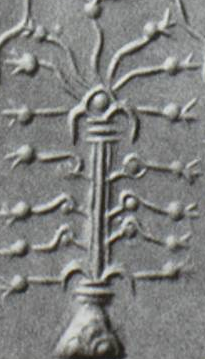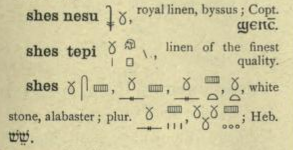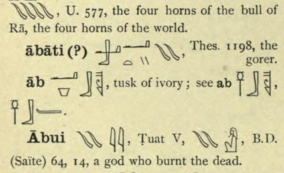RESTART
[extensive description of their region North, matching the spells]
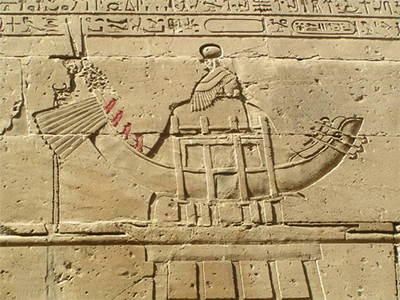
textnote:
we are aware that often people read words at face-value, and many think a term as “the land” should is ofcourse “this earth, we live on” — but a term like this is decided from the context it is placed in; for example, “Egypt” is a real country during the exodus, but always represents Sekhet-Áaru when the term is used in prophecy. Related to this face-value is a second problem, namely the line-up of the words being used:
there is the “interlinear version” (which we use), and there is the other version (from which most modern versions are taken from, as KJV); but this version is often “switching words” in a sentence, and when object and subject have switched places, it often renders a different meaning, altogether. We consider this was done on purpose, in order to “keep the adamite soul thinking like Job”, using “sorcery by words”: because sorcery is typically about “creating another consciousness by hustling the order of words”; and we consider the added term as “reverse interlinear” to be no accident.
note: our interpretation of the line in purple; possible interesting terms for you in the notes in darkblue ; we apologize for each time the extensive notes, it makes things very unreadable, but Vital for context; we added other (legal) possible readings in red , glued to objectword,
note #: chapter containing much Legal importance,
| Ez. 27 | 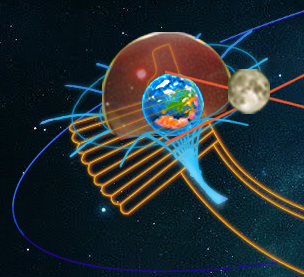 |
| 1-2 and·he-is-becoming word-of ieue to·me to·to-say-of and·you son-of human lift-up-you! over Tyre dirge The word of the LORD came again unto me, saying,Now, thou son of man, take up a lamentation for Tyrusline, “and he is becoming / the word of / IEUE / to me, / toby to say, / andfor you / son (adamite-soul) of / the adam-male, / lift up you! / over / the city of Õn (Tyre) / the lamentation; “ |
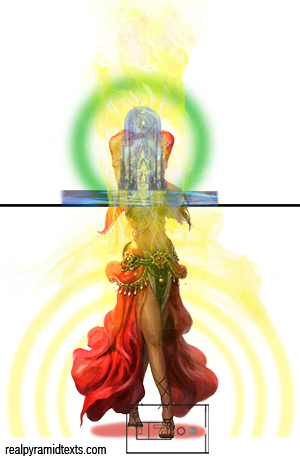 |
3
and·you-say to·Tyre the·one-dwelling on entrances-of sea one-being-trader-of the·peoples to coastlands many-ones thus he-says my-Lord ieue Tyre you you-say I consummation-of loveliness
And say unto Tyrus, O thou that art situate at the entry of the sea, [which art] a merchant of the people for many isles, Thus saith the Lord GOD; O Tyrus, thou hast said, I [am] of perfect beauty
|
 |
glyph pic: striking the ‘iy’ and here ÁA (ÁA-tiu, ‘the great canal of Heliopolis’ as Õn),
note: she is trading IN peoples – compare Revelation 18:13 “trading in adamite-souls”, because ‘Babylon the great’ is renamed as Õn (so ‘Babylon’ is not “the USA”, not even “this earth”, because the latter is but a subsidary of her),
line,
“and you say / to Õn, / the one dwelling / onat / the entrances of / the eden-dimension (sea), / the one being the trader óf / peoples / tó / the – many – isles (ÁA); / thus / he says / mylord / IEUE: / you, / Õn, / you say: / “I (am) / one large burning sacrificial / beauty”;”
4-5
in·heart-of seas boundaries-of·you ones-building-of·you they-completed loveliness-of·you firs from·Senir they-built for·you all-of planks cedar from·Lebanon they-took to·to-makedo-of mast on·you
Thy borders [are] in the midst of the seas, thy builders have perfected thy beauty. They have made all thy [ship] boards of fir trees of Senir: they have taken cedars from Lebanon to make masts for thee
pic: diagram of 16th century warship; main mast as great pillar ÃÃA; the ‘multiple masts’ glyph pic: the ÃSH,”the tree / (by) essence / of the sh-pool (eden’s) / for willpower (matrix)”, ÃSH also as “multitude (of spirits)”, where at the end of chapter this multitude will fall; |
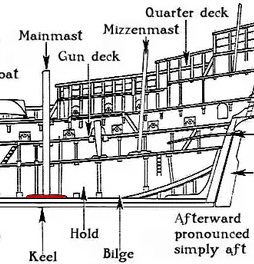 pic: quora.com 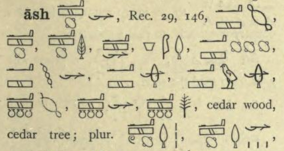 |
location: in previous line, Õn “sits upon the entrance tó the eden-dimension”, entrance as north-stargate (in outer court); compare how Marduk “drove an evil storm into Tiamat’s (eden) belly”; we think to read that “his borders come down and extend tó the stargate (as north-gate of inner-court)” –
line,
“into the heart (stargate) of / the eden-dimensions / (are) the borders (territories) of you; / the ones (fallen angels) building you / they completed / your beauty: / (by) cypress trees (generative power) / from the Watchers-realm / they built / for you / all of / the tablets (and planks of deck), / (and) the cedar / of white dimensional-adhesive / they took / to makedo of / the great pillar (mast) / upon you;
6
oaks from·Bashan they-madedo oars-of·you prow-of·you they-madedo ivory daughter-of-Assurites from·coasts-of Kittim
[Of] the oaks of Bashan have they made thine oars; the company of the Ashurites have made thy benches [of] ivory, [brought] out of the isles of Chittim
glyph pic:
|
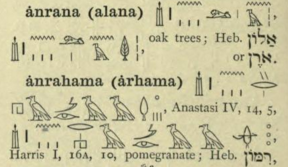
|
- 2) ÁN NERHAMA, “pomegranate” (highpriest robe had to be made as depicting these), “the lights / (by) the tree / (to reap) for Sight, / (by,for) to descend hebrew-H / (as) the mouth (eden’s) \\ (for) existences, / (being) the column of Õn”; an even móre impossible term; according to this term, the pomegranate is part of eden, because of the magically-dangerous-\\, but this tree returns surprisingly few times in scripture: H7416 rimmon ‘of foreign origin’; NE-RHAMA and ‘ri-mm-on’ can be of similar root.
Akk. nurmú ‘pomegranate’, narmaku ‘bathroom’ (how’s that linked?); even we take the -n and keep r-m, rimu ‘to murmur, to roar’; ramâmu ‘to clamour, roar’, ramku ‘incantation, sorcerer, spell, garment,
a figurine’ (we had this ramku, before), yet the whole context here sounds Off.
Turning to Rg-veda, not by root but by theme, [see ‘red’ in line 7], dãDima ‘pomegranate’ MH; from root dad-, ‘gift, to give’, dadha, ‘giving’ RV; dadhan-vat ‘containing coagulated milk’ RV as ‘with – the thing given’; dahimuka ‘a monkey – brother in law of Sugriva’ RV (sugriva was a monkey-captain in Setu-bridge; the “in-law” interesting because hebrew has too the concept of “uncle”, as “related aspects, but not of the same household”); the whole cluster as “milk, sour thick milk”; dadh-yac ‘name of a mythical RSi (fallen angel) or sacrificer, having the head of a horse, and teaching the áśvin’s (spirits-constructs) to find in tvaSTR’s house (kheper beetle) the soma (words of Watercourse); favoured by Indra who slays 99 vRTRa’s (eden-tile) with a thunderbolt (axis) made from his bones ‘ RV; dadhyãśir, “milk mixed with soma to purify it (the soma)”, RV (many); (Ãśir ‘to mix’) b] the tree yamalârjuna ‘(dual nr.) two arjuna-trees, which obstructed the path of kRSHNa (osiris), and were uprooted by him’ RA; as composite of Yama (Adam) and Arjuna; the latter an obscure aspect meaning ‘white, daylight, dawn’ RV, again the dual-lampstand; same dual as glyphs to right; concluding that the pomegranate must represent the nature of un-directed feminine, here opposed to the oaks as the nature of the undirected-masculine,
the pomegranate and fig-tree returning in Haggai 2 as “being the vine – but without the Watercourse”,
pic: sumerian tree of life as pomegranate
- ‘ashurites’, H833 ashar, can be anything 16x; more likely H836 asher, son of Jacob, (since Asher carries as one of 4 sons – from the 12 – an important attribute of the matrix); it is supposed to be ‘happy one’, but that is totally Senseless; as is looking by name to sanskrit asura-, ‘chief demon, opponent of the gods’ RV (many);. 2) we have more chance with the son Asher: in Gen.49, Asher is related to ‘bread,food’ (aspects for the body-garment, in the spells), and ‘royal delicacies’, the royal as “melek” (matrix king), and ‘delicacies’ curiously used in 1 Sam.15 related to Agag, king of the Amalekites – a type of dead-bodies — so the link between “ivory – Asher – body-garment-aspects” seems valid; b] it seems in Deut.33 is added to him “your bolts of iron and bronze are strong”; which makes only sense when related to the KHENT’U throne, as centre of the boat-construct; where the bolts can be the glyph -S (adamite soul) as ‘bolt’, by who they made those constructs (or less likely “the 8 pegs” UG- ),
c] we seem to need a feminine-related theme, opposed to the masculine oaks; this feminine can be indicated by the term ‘daughter’ — we can only assume that the NEB-chalice is this hull, that the chalice is feminine (Nephthys goddess representing it), represented by Asher; - ‘kittim’, H3794 likely foreign, but verb ‘katat’ as ‘to hammer, to beat (to dust or to pieces)’; perhaps from the Hittite empire (as Khati); when transponding phonetically then KH-house or even KHET-branch? because of the connection with bolt/Asher, previously? The term is always used in plural ‘kittim’, pointing to the seal KHETEM..? The only other lead is ‘he being a son of Javan’ (of the 3 sons of Noah),
note: the islands ás the seal-ring sounds like the QERRT-caves around the q-axis;
what concept could suffocate an axis ‘better’, as a grouped series of rings..?
line,
“(by) the ascending oaks / from the M-realm / they madedo / the ‘rudders of heaven’ (4 poles below boat-construct) of you; /(and) the hull (NEB-chalice) of you / they madedo of / ivory, / (being) the daughter-concept of those of Asher, / fromby the isles of / (the place of) the seal-ring; “
7
cambric-sheen in·embroidery from·Egypt he-became spreading-of·you to·to-become-of for·you to·banner amethyst and·purple from·coasts-of Elishah he-became covering-of·you
Fine linen with broidered work from Egypt was that which thou spreadest forth to be thy sail; blue and purple from the isles of Elishah was that which covered thee
- ‘fine linen’ H8336 shesh (‘of foreign origin’); word used for tabernacle curtains,but also when creating man, Ez.16; yet for the priésts’ garments (as well as the ‘man in linnen’ in Daniel), the used word is H906 ‘bad’ — suggesting that this latter type linnen is a ‘solarplane-type’, read, ‘polluted, mixed’. (third version butz, below) Glyph SHES- often used in spells, perhaps inversion of the secret place SESHT;
- ‘sail’ H5251 nes, ‘standard, banner, sign’; once used in Is.33 as likely ‘sail’ [do next, same theme]; though a glyph as ‘jackal staff’ would suit context here..? Used for ‘the serpent upon the pole’ during exodus; H5127 nus ‘flee, escape’ (many),
- ‘blue (amethyst)’, H8504 tekeleth ‘blue’, (unknown derivation), tok ‘oppression’ 3x psalms;
- 2) teqel “be weighed” (famous ‘mene teqel’), said from shaqal ‘to balance’, then why not this too, ‘shekeleth’? the ‘to weigh’ is either way Negative – then this ‘blue’ must be, too; perhaps KHESBET’;
- 3) other way around, when added-T (têkelith, t seems added), then keliy ‘vessel, instrument, etc’; but even then similar colour as brow (chakra); word in Akk. said to be hasmânu; the Eden blue: H5601 sapphire — poisoned blue: this H8504 tekeleth,,: Sanskr. mahAnilopa —,,: KHESBET’, and Sanskr. kâla
- 4) Sanskr. câSa, ‘blue jay’, RV, MH; kâla- ‘black,dark blue’ MH, RA (to Kali, likely); kRSNa same RV; maniśyAma,’blue like a jewel (sapphire)’ RA, maNi ‘jewel’, yAma ‘chariot’ RV but from Yama, Adam, and the ma- always as Eden; as mahAnilopa ‘blue stone, sapphire’ RA, MH; câSala ‘wooden ring on top of sacrificial post’ RV (câSa, as the beryl of cherub-wheel?), no further; kâla, ‘name of a raksas’ RV (raksas=evil); ‘name of a mountain’ RV,’to calculate, season’ RV RA; ‘destiny, faith, time (often in relation to Yama=adam)’ RA, MH, RV; kâlacakra ‘wheel of time’ RA; kâlacakra ‘wheel of fortune (sometimes regarded as weapon)’ RA, other name of sudarsana?, kâladaNDa, ‘staff of death’ RV RA; (daNDa ‘staff, sceptre, pole, etc’, – daNDa ‘name of a raksas’ RV), cluster has the colour of VaV-sceptre (lute is mentioned, punishment, etc),
| glyph pic: the “wide, spacious” as USEKH only used in spells for Sekhet-Áaru, made using the adamite-soul -S; and note the fortified-hebrew-H glyph; we saw in another page that “the house of IEUE was flung to the other dimensional side (north)”, ‘spaceous-glyph’ visible as the a bit square cup ÃA (is the choice of Elisha a pun on u-se-kh?),glyph pic: SHES, often used in spells (particular BD) “the veil / (for) the adamite-soul / (by) the sh-pool (eden’s)”, whether dimensional or as garment-body; lower as “the lights / (by) the eden-tile / (as) the shes Veil” — these veils wee the “side-walls of the sanctuary which Elam and Kir broke through”; and these until now “standing upright, as the ponytail”.
glyph pic: SHESAT ‘cunning, wise, skilled, learned, etc’; for us important because of SHESAT, the flame coming out through the north-gate (see diagram), as “inversed word”: SHESAU, “the tongue / by the word / to make to inverse”, the tongue being the ponytail also — but now pictured as “the tongue hanging-out of the Õn stargate, into the eden-sh-pool”; |

|
- ‘purple’ H713 argaman; unknown; ‘assyrian argamannu’, no argaman but there is armannu ‘tree’, or argânu ‘conifer’, hardly purple-related; H707 ‘arag ‘to weave’ 12x (weaving is always negative); Akk. tabarru ‘purple’, also uqnû ‘lapis-lazuli, shining’, lapis is blue — then the book mixed up both?
Sanskr. nîlalohita, śoNa, vâyu (Rg-v), vâyu as an Indra type stormgod; vâ- is negative (from va-); śoNa ‘river going north, then 500 miles to east’ RA, MH; ‘red horses of droNa’ RA, MH, where droNa is the soma vessel (probably the hewn-out cistern as north-sh-pool); nîla-, ‘monkey chief’ RA, ‘nâga-serpent’ MH; (nilaka, river’, nilakantha ‘blue necked’) nîlalohita ‘blue, purple’, and ‘name of Shiva (Osiris)’ MH, when he drank poison and his throat got blue; dhûmralohita, dhûmra- ‘monkey’ RA-, ‘name of Shiva’ MH; where dhûm- is ‘smoke, vapour, mist’ RV as root;
purple/red theme:
- 1] Eden-red: Adam (dimensional-garment)
Rg-veda: rudra
poisoned red: H119 adom (Edom), context: ram’s skins – used only for tabernacle roof-curtain, and the ‘shield (mgn) being made red’ (as the dome);
glyph: likely T’EMIA, (stepdown from AT’M, Adam),
Rg-veda: roh- cluster (fish), from rud-; - 2] Eden-scarlet: H8144 shani, (inner garment);
used for the hanging Veils of tabernacle (side-wall of sanctuary), and as priestgarment: (used: blue (tklth), purple (argman),scarlet (shani) and red-purple (tola); used in both); 2] used for ‘scarlet cord’ of Rachab, and the scarlet cord of ‘the breach’ (same theme);
poisoned-scarlet: H713 argaman,
Jer.10:9 as same theme as this chapter, mention “blue (tklth) and purple (argman) their garment”;
Rg-veda: likely śoNa, note the phonetic!,
glyph: T’ESHER; - undirected-feminine-red (?): H8438 tola; negative; [see ‘pomegranate’ in line 6]; tree and worm-related the worm also to ‘manna’ (juice from a tree), affirmed by the ‘worm in Jonah’s tree’; Jonah was sitting next to their stargate (Nineveh), which IS the priest-garment;
Rg-veda: likely aruNa, ‘red’, aruNa ‘dawn’; term close to VaruNa and arjuna, as silver-realm and ‘dawn’,
- ‘elishah’, H437 3x, ‘foreign origin’ (what?), ‘wide, spaceous’ + deity (better here as ‘saves+deity’);
continuation: in previous line NEB-chalice and QERRT-, now it makes sense that the Fields are addressed;
line,
“you being stretched-out / inby the variegated (and embroidered) / dimensional (eden-) Veils / he became / fromas Sekhet-Áaru, / toby to become of / for you / toas the sail banner (as having escaped), / he became – the blue (khsbt’) / and purple (t’shr) / fromas the coastlands of / the (dimensional-) spacious-deity;”
— the verses about localities and trading; please compare to map, right, where all the places are either within the ponytail, or above the cube —
8
ones-dwelling-of Sidon and·Arvad they-became ones-rowing for·you wise-men-of·you Tyre they-become in·you they pilots-of·you
The inhabitants of Zidon and Arvad were thy mariners: thy wise [men], O Tyrus, [that] were in thee, were thy pilots
|
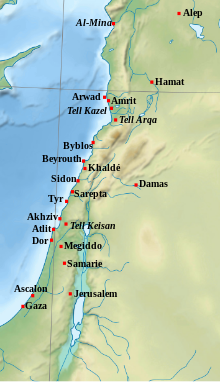 |
line,
“the ones dwelling ofin / the base of the wick-H’ / and Utchat (arvad) / they became / your ones moving-to and fro; / the wise men of you / they become / infor you / Õn / (as) they – the wick-H’-handlers (caduceaus-handlers);”
9
old-ones-of Gebal and·wise-men-of·her they-became in·you ones-repairing-of gap-of·you all-of ships-of the·sea and·mariners-of·them they-became in·you to·to-mix-of market-of·you
The ancients of Gebal and the wise [men] thereof were in thee thy calkers: all the ships of the sea with their mariners were in thee to occupy thy merchandise
glyph pic: the KEBEN is a bit non-term, K- as k-axis; also ‘ship of Byblos’ as KAPEN (stepdown), where KAPU- is “hollow of the hand, sole of the foot” (into the false hebrew ‘hand – as kaph’); for us interesting because this must be the predecessor of the “hollow hand TCHERT”, as well as the reason for the ‘sandals’ THEBT; the KAP- is “to perfume” in spells, occasionally used, KABUSA “the coverings to inverse” (paraphrased) as the Veils of the eden-tile; compare the diagram where Enki puts one foot (as hollow of the foot) upon the dome of the eden-tile, and the same theme of the Hermes (Thoth) statue, bending over to fix his sandals (see Tut pages);
|
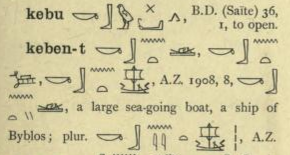
|
line,
“the olden ones (fallen archangels) of / the border (as hollow of the foot) / andas her wise men, / they became / infor you / the ones hardening-out (as heart) / your fissure-breach, / (being) all of / the boats (constructs) ofby / the eden-dimension (sea) / andfor the ones moving to and fro (spirits): / they (the spirits) became / inby (means of) you / to exchange / your altered-merchandise;”
10
Persia and·Lud and·Phut they-became in·army-of·you mortals-of war-of·you shield and·helmet they-hang in·you they they-gave honor-of·you
They of Persia and of Lud and of Phut were in thine army, thy men of war: they hanged the shield and helmet in thee; they set forth thy comeliness
- ‘persia’, since it’s used – H6536 paras ‘to divide (the hoof of an animal)’; likely it is related to previous line with the “sole of the foot” for some reason, but we’ve no idea why, yet; since it is avestan, sanskr. root per-, peru ‘carrying across, rescuing, swelling or causing to’ RV; par- (root as ‘paring’) para ‘enemy, anyone other then own self’ RV, para ‘supreme being’ RA, para ‘remotest distance’ MH; paras ‘over, more then (locative)’ RV in context “better then” since the par- root was ‘extremes’; parSa, ‘a sheaf, a bundle’ RV (glyph TCHEB?); next is root pAr- (but following on par-), pAra ‘opposite side, further limit, etc’ RV; as dimensional side; pArasa ‘persian’ (just scholar); pArasîka ‘the Persian’ MH; root pRS- ‘to vex, to weary, sprinkle’ RV; the term paras used in the “counted / weighed / divided” by the hand at the wall in the Persian court;
- ‘lud’, no root whatsoever; Akk. luddin ‘tablet of sale’; but we need a ‘region’ here – therefore unlikely the same as Ludd H3850; however, 1Chron.12 “the 3 sons of Elpaal (making-deity) who built Õn and Lod”, perhaps this is the SESHMT region of 3? or their other side, KHEMT, ‘3’, from Khemenu mountain? no sanskr.;
2) Sum. LU ‘heap up, live, dwell, pasture, to mix, to twist’, LU AD ‘an official’, LU DU ‘runner’, LU DUN A ‘ward, dependent’; LU DUN TAG ‘pig butcher’, LU(3) ‘offering-cake, to mix’ (cluster going into Lugulbanda etc), “to mix, live, dwell, runner (=revolving), butcher = matrix?” - ‘put’, same problem, no root; no P-T root in Sumerian; Sanskr. phut, empty; but there is put- ‘particular hell (to which the childless are condemned)’ MH; puth ‘crush, kill, destroy’ MH; puttIka, ‘white ant or termite’ MH (ah, the ‘louse’ in CT as proto-spirits), putra ‘son, child’ RV; putrIka, daughter’ MH; then step-up pûta-, ‘clean, bright, purified, etc’ RV; pûtâNa, ‘name of female demon who offered her poisoned breast to kRSHNa (osiris) but he sucked her dry’ MH;
- ‘shield’ as magen; also in other pages ‘covered red’; we ‘re still searching,
- ‘helmet’ H3553 koba (‘unsure’); 3551 keeb ‘pain’ (kaaba again); into qab- etc; context of ‘helmet’ must be “their sons wanting a head (instead of 2 snakes)”, [review]
- ‘honor’, the same hadar- as matrix-comeliness (by Me); other page;
note: we have no clue yet what is with this ‘shield’ – as some inversed dome?
note: Lud and Put as descriptions of the matrix would match ‘humankind, as Õn’s army’,
line,
“the dimensional other side (or background?) (persia) / andfor earth’s matrix (?) / andas the particular hell (?), / they became / infor the army of you, / (namely) the human mortals (mankind) / (being) your battle; / they hang down – (namely) the shield (a dome) (mgn) / and the helmet (head) / in you /, they / they give / your (matrix) comeliness;”
11
sons-of Arvad and·Helech on walls-of·you round-about and·Gammadites in·towers-of·you they-become cuirasses-of·them they-hang on walls-of·you round-about they they-completed loveliness-of·you.
The men of Arvad with thine army [were] upon thy walls round about, and the Gammadims were in thy towers they hanged their shields upon thy walls round about; they havemade thy beauty perfect
- ‘helech’ H2428 chayil, ‘strength, efficience, wealth, army’ but with capital here, chuwl ‘writhe, dance, bring forth’ (create); place east of the Jordan (how?),
- ‘gammadim’ H1575, no root; gomed as ‘short cubit’; 1573 gome ‘rush, papyrus’; Akk. gamãru ‘bebt stick, shepherd crook’, ‘old, long lasting, complete’; others say Akk. gamatu ‘a measure’; if ‘gamad’ is “slang for dwarf” then because of the short cubits – anf the -im is just ‘multiple’?; Akk. gamãlu ‘to carry out a task’, very close to the two gallu-demons with Inanna; dwarf BES?
| pic: the Ba-spirit-souls often depicted ‘standing upon the house/tower’, here from Nefertari’s tomb, where she and her Ba-soul are depicted; |  |
| pic: the torso, the region from chest down until (inclusive) the pudenda; factually as a dirty mix-up of ape-intestines, and the attribute of Eve; created as ‘Bes’, |  |
| pic: Bes dwarf, with protruding tongue; pictured “alongside the tower/house”, but likely he is “the image of that tower itself” – “the dwarf / by the adamite soul / for the solarplane”. |  |
The theme is the step-up:
- 1) the neanderthals, cro magnons, etc, were the ape-bodies inhabited by a fish-soul,
- 2) their heads are depicted beneath the Bes-dwarf, he stands upon them – as newer version
- 3) the Cain-souls (egyptians and offspring) are fish-souls, too,
- 4) but now got for them the Bes-dwarf new type body, as a mixture with eden’s aspects,
- 5) the Bes-dwarf body being the same type body we have now,
- 6) but upon the dwarf’s body is written ‘to become a khu-spirit’,
- 7) and the goal is to receive their superior spirit-body: as the Ba spirit-soul, the bird;
- ‘shields’, H7982 shelet, shalet/shaliyt ‘to master over, to rule’; sheol+t? shelet ‘signboard’? we found Akk. śãltu ‘combat, strife, fight’; salãtu ‘crush, grind, split open, outside, other side, behind, liver, back, etc”, sîlitu ‘membrane, womb, afterbirth”, so which? context says it can be ‘something of gold’, and it must belong to the dwarfs; ‘defensive armour over the torso and the back’, similar to the apron of highpriest (yet shorter)?
context: the covering of Õn seen as “garments, hanging down over the walls”, similar must be “the apron of the highpriest, hanging down from his shoulders”, there is obviously a connection with previous ‘shield hanging down’, but we fail to see the concept,
line,
“the sons of / the Utchat (arvad) / andas the place of wealth and capability (helech) / onby / the – surrounding – walls of you, / andfor the Bes dwarfs / in the towers (mgdal) of you / they become (to have)/ the artificial physical torso offor them; / they (the torso’s) hang down / onas / the – surrounding – walls of you, / they / they completed / your beauty;”
12
Tarshish one-being-merchant-of·you from·abundance-of all-of wealth in·silver iron tin and·lead they-gave fairs-of·you
Tarshish [was] thy merchant by reason of the multitude of all [kind of] riches; with silver, iron, tin, and lead, they traded in thy fairs
- ‘tarsish’ as “beryl” said of cherub wheel; later in Dan. the cherub body as beryl;
- ‘merchant’ as trade, trader – trafficker glyph SHU?
- ‘tin’, root H914 badal ‘to separate’; “separated light fom dark” Gen.1; sic, is plummet TEKH for separating dimensions by place-T, as “dimensional plummet” (centre-point),
glyph pic: T’EH’U as ‘lead’, same root as Thoth; since his “place-T \\ (by) the Thoth perch-region” is so often used (the \\ shows it’s illegal), we think it is valid to make “the plummet to be the lead”,
|
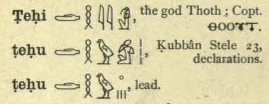 |
note: the “(lights of) iron (character)” seems a bit overdone, but we think the aspects need be included; see other page and page for the “weighing the 30 silvers for them”,
line,
“the place of beryl (cherub wheel – eye) / being the one traded ofby you / fromfor the abundance of / all of / the easy wealth, / inby the (eden-) silver / (being) the (lights of) iron (character); / (and) the dimensional plummet (tin) / andas the lead (diffusing lightparticles) / they gave / your merchandise; “
13
Javan Tubal and·Meshech they ones-being-traders-of·you in·soul-of human and·articles-of copper they-gave market-of·you
Javan, Tubal, and Meshech, they [were] thy merchants: they traded the persons of men and vessels of brass in thy market
- ‘javan’, unlikely a semitic root; as yavan, not the same as yaown; and similar problem as with (the plain of) Aven; sanskrit yava ‘wheat or corn to make flour’ RV, (rootmeaning) but also ‘double convex-lens’ listed (sic); yavadvîpa ‘the island java’ RA (sic), Javan being Greece in symbology; Yavana, ‘greece’ MH; yava undeclinable; cluster is long but seems to use the word within others, therefore the only solid meaning we have is ‘grain-corn’; in context perhaps just as “the modern West (on earth?)” since the goat is ‘Greece’?
- ‘tubal’, also foreign; it’s nature is ‘blacksmiths etc’, which is glyph MESHEN “blacksmiths of Horus”, Sum. TU-BU-UL ‘compound verb element’, TI BAL ‘to turn sideways’, TAB ‘twin, double, to repeat, to grasp, to mark, to burn, to brand’ (has relation with Workplace and ‘to double’); sometimes Akkadian is similar – but oftentimes not: in Akk. we saw tublu ‘gate tower’, tebû ‘to raise the hand, swell, plunder, rise, expand, raise’, tabiltu ‘a pot’; we guess there should be sóme semitic colour in the word; but likely as invented root, from t-b t-v ‘good’ added -l, perhaps to show “a different type good”, in Sanskrit tub- is a root but no separate meaning; perhaps as the inside of the Bes-tower, blacksmiths referring to the Workplace, the cradle MESKHEN is in the centre of the Sekht-fields (see map),
context: the picture emerges here, that specifically the modern West, as the region where both the house of Israel ánd the house of Judah mixed into the other nations (yes: until this very day); and that Canaan’s occult rituals (as blacksmith), are as usual specifically directed tó the West, as the trade in souls,
note: we don’t know whether “the adamite-souls have a brass nature, themselves”, or whether they are “used fór their copper vessels (body)”,
line,
“the modern-West / (being) the blacksmiths’ gate / andfor the region of the birthcradle of Osiris (in S-Áaru), / they / (are) the ones being traded ofby you / (namely) inas the adamite soul of / the adam-male, / and(as?) the vessels, jars of / copper-brass / they gave / your merchandise;”
14
from·house-of Togarmah horses and·horsemen and·mules they-gave fairs-of·you sons-of Dedan ones-being-traders-of·you coastlands many-ones merchandise-of hand-of·you horns-of ivory and·ebony and·ebony they-recompensed levy-of·you
They of the house of Togarmah traded in thy fairs with horses and horsemen and mules. The men of Dedan [were] thy merchants; many isles [were] the merchandise of thine hand: they brought thee [for] a present horns of ivory and ebony
- ‘togarmah’, suppose we keep ‘garm-, then Akk. girimmu ‘a fruit, tree, olive, flower’, gûru ‘foilage, forest’, girru ‘lion’, gerû ‘hostile, to challenge’, poss. Ugar. grm ‘mountains’,; sanskr. only gara-, ‘poison’ RA; H1620 gargar ‘olive’ 1x, see Akk., 1616 ger- ‘stranger’ (many); 1615 gir ‘chalk’1x (Is.), the white of Lebanon, also gir- 1x (Dan.); guwr ‘sojourn’ (many; is stranger); gor ‘(lion) whelp’, see Akk.; when -t changed, (same as ‘blue’ in tekeleth-shekelith, in previous line) then perhaps even from sheger “offspring, young of beasts” + mah (or better m+ah ‘which belongs to term’),
2) if we do the same trick in Sumerian: TUG (tug2) has many versions; root TUG ‘garment’; TUG.MAH ‘a garment’, TUG.UR ‘a cloth trimming’; TUG KU RU UM ‘a mourning garment’; TUG GUM MA ‘a type of garment’, TUG GUR ‘a plow, to plow’; for a foreign name ‘to gar mah’ is valid enough; note how “garment” relates to “spirit-bodies”,
| glyph pic: the T’ET’UN occasionally appears in spells; as “the evil / to become new / (by) the doubled hand (executive region)” (dangerously written, because ‘evil must not become new’); more often “the deity / to become new / etc”, glyph pic: ÃB, ‘horn’, “the 4 horns by the hand of he” as 4 horns holding up the Torus; the ivory AB coming from ‘ebony’,HEBEN, hebrew-H as changed nature, |
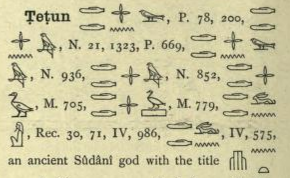
|
- ‘mules’, also 6504 parad, ‘to divide’ (as eden rivers divided), 6507 ‘grain, seed’ (?), Akk. parâdu ‘scared, terrified’; pi’rû ‘sprout, offshoot’ (that seed?), parrû ‘transvestite, homosexual lover’ (sic), purIdu ‘leg of animal, haunch, lap’; “ithyphallic ones” from spells,
- ‘dedan’, double-D very rare (just as Byblos is), only other term with d-d is H1717 dad ‘breasts’ 4x, as defiled; lines in egyptian context; where ‘breasts’ glyph MENTCH- is always stargate; close to dud ‘uncle’ (as far relative genes), dud ‘basket’, on to David; context can relate only to dwd; d-d only as Akk. didallu ‘ashes’ and dadmû ‘world’ (also Sum.); it may appear that we choose but randomly – but the ‘hand’ at the end of the line suggests that glyph T’T’UN (d-d-un) is intended,”by the doubled-hand to become new”, (or the literal Djed-pillar TCHET’?),
- ‘present’ H814 eshkar ‘gifts, payment’ 2x, unsure; esh- as ‘fire’, and kar- ‘(battering) rams (=lambs)”, linked to sakar ‘gifts, rewards, wage, hire’ but then we loose the colour,
note: Togarmah is said “to be in the North”, perhaps even as glyph MESQT “house of the bull skin”,
line,
“from the house (in the North) of / the garment-bodies / (being) the spirit-constructs (horses) / andfor the ugly spirit-bodies, / andas the ithyphallic ones / they gave / your merchandise; / the sons (constructs) of / the double hand / the ones being the traders of you / (as) the many – islands / the merchandise of / the (serpent-) hand of you; / the – ivory – horns of / andby the ebony (by eden) / they caused to return (w-course) / your hire (eden aspects);”
16
Aram one-being-merchant-of·you from·many-of doings-of·you in·carbuncle purple and·embroidery and·fine-linen and·corals and·brilliant they-gave in·fairs-of·you
Syria [was] thy merchant by reason of the multitude of the wares of thy making: they occupied in thy fairs with emeralds, purple, and broidered work, and fine linen, and coral, and agate
- ‘linen’ H948 buts (-tz term), bots- mire, to Bozrah botsar,
- ‘coral’ H7215 ramoth ‘coral’ (‘dubious’); to H7214 reem ‘wild ox’ (as Joseph in other page), raam ‘agitated, to crash (of thunder)’; same Akk. cluster? as Akk. ramãmu ‘to roar, thunder’, ramku ‘garment, a functionary’, ‘incantation, spell, sorcerer, figurine multicoloured, young male, be clean”, râmû (verb) ‘set in place, lay down, cast, release, etc’; râmu ‘to love’; rîmu ‘wild bull’, wild-ox context unsure,
- ‘agate’, H3539 kadkod ‘perhaps ruby’, said from H3537 kad ‘pitcher, jar, bowl’, Is.25 seems to use the word as gem in relation to ‘windows’ (but corrupted?), Akk. no k-d; [review] jar, and windows (as gate?) and gemstone? unsure
note: last part of line won’t run; too much unsure,
line,
“the sorcery-land (earth matrix) / the one being the trader of you / fromas the many of / doings of you / infor the multitude; /(being) the purple (garment-body; t’shr) / andas the variegated and embroidered / (and) linen (from Õn), / andby the wild ox (eden) / and (the precious stone as gate? – eden) / they gave / infor your merchandise;”
17
Judah and·land-of Israel they ones-being-traders-of·you in·wheats-of Minnith and·pastry and·honey and·oil and·balm they-gave market-of·you
Judah, and the land of Israel, they [were] thy merchants: they traded in thy market wheat of Minnith, and Pannag, and honey, and oil, and balm
- ‘minnith’, from H4521 menath ‘portion’, to glyph MENÁT, mooring-post? same as previous “to count, to number” (by mene tekel pharsim), (country Minni); H6436 pannag ‘cakes’ 1x, no root; pen- ‘corner’1x; panah- ‘turn (away)’;
2) Akk. pannigû ‘pastry, a type bread’, pingu ‘type of bird’, hm;
line,
“Judah / and the land of / Israel / they / (were) the ones being traded ofby you / inas the wheat of / the place of counting (menát?), / andas (pastry), / and honey / and oil / and balm / they gave / your merchandise;”
18
Damascus one-being-merchant-of·you in·many-of doings-of·you from·abundance-of all-of wealth in·wine-of Helbon and·wool-of Zahar
Damascus [was] thy merchant in the multitude of the wares of thy making, for the multitude of all riches; in the wine of Helbon, and white wool
- ‘helbon’ H2463 chelbon H2461 chalab ‘milk’; 2469 cheleb ‘fat of kidneys etc’,
- ‘wool’, strange theme; wool is ‘hair’ ofcourse, but it appears bad to wear wool; perhaps related to ‘hairy’ of the spells? (ape-bodies were hairy),
- ‘zohar’, H6713 tsachar ‘white’ 1x; yes, because of ‘wool’ eh; root perhaps ‘dizzy, making dizzy’ (-tz term); Akk. śaharru ‘(fish) net, a vessel’ (from Sum,SAR); śahurru ‘part of a temple’; śuhhu ‘a stand, buttocks’ (glyph H’EP – root-P); sâharu, ‘go around, encircle, confine’,
note: ‘wine’ as glyph ÁRP (by matrix-root); then shouldn’t the root-place belong to the wine? the “house of fat” is always glyph ÃT,
line
“the staff-tá / the one being the trader of you / in many of / doings of you / fromfor the abundance of / all of / the cheap wealth, / inas the wine of / the house of (eden-) fat (?) / and the wool (-garment?) of / the place of the the matrix-root-P (?);”
19-20
and·Dan and·Javan from·Uzal in·fairs-of·you they-gave iron wrought cassia and·reed in·market-of·you he-became Dedan one-being-trader-of·you in·cloaks-of free-flowing for·chariot
Dan also and Javan going to and fro occupied in thy fairs: bright iron, cassia, and calamus, were in thy market Dedan [was] thy merchant in precious clothes for chariots
- ‘dan’ from H1777 din ‘to strive, to judge’, UTCHÃ? Akk. dannu ‘strong, powerful, mighty, wrestle, noble’; dînnû ‘bed’; dînû ‘lawsuit legal decision’; dînu dânu ‘to judge’, dunnû ‘fortress’; Sumerian probably phonetic invalid; 2) the line in Deut33 “Dan shall leap from Bashan”, where ‘leap’ is 1x zanaq, ‘leap’; but most likely as 2186 zanach; ‘reject, cast off from’; “Dan shall be rejected from/by Bashan”; Bashan the M-realm; so the judging UTCHA as “the eden-word to command” MET’U will be rejected;
- ‘uzal’ H235 azal ‘go, gone, evaporate’, but tricky because of -az and -el; Akk. aslu type sheep; unit of measurement or time’, aślu ‘reed, rushes’, aślâku ‘fuller’; the latter important as “the fuller’s field by the upper pool” (fuller is washing clothes by beating them); aslû ‘reed, rushes’; aśilâlu ‘decorative fancy work’; none of them fit the important UTCHA; we consider a mirror-word here, -az and za- (+l); -az when eden-power, za- when theirs; we should have a bit of a case because of the capital-U as ‘place’,
| pic: their [cassia-] tree upon the place of the eden-dome; the dome as same shape Enki stands upon, (and same as glyph H’EM-, the rudder) compare the lampstand-form, for inverted khepesh-thigh see vignettes in opening of mouth pages; | 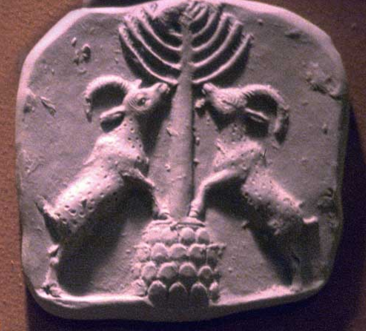 |
- ‘bright’ (wrought)’, H6219 ashoth 1x; 6249 ashte ‘eleven’, “11 curtains of goat-hair as roof-curtain of the tabernacle”, 11 is nonscriptural, 9/11; goat is the darkness of Rã, soon; esheth, ‘carved’ 1x (also fuller), turning into Ashtoreth;
- ‘cassia’ H6916 qiddah 2x, no root; said from qodqod (but we saw in spells it is the dóubling which is Off); 6915 qadad (qadd-) ‘to bow down’ 15x; into qaddish and qadesh ‘holy’; in the entire Akk. we can’t find any ‘cassia’ not even listed in ‘trees’; context shows it must be a spice (Ex.30:23); Rg-veda doesn’t seem interested in the cassia; in glyphs an option is said as KHESAIT, “the blossoms (eden-words) / of place-T of the most-b-soul-adam / to inverse / (by) to spin-around (for KH-house”,
- ‘calamus (flowing)’ H2667 chophesh 1x, no root; (capital C), chaphash ‘free’ 1x; chaphas, śearch (out), hide’, chupshah ‘freedom’ 1x; chpshiy ‘free’ 17x;
note: term for shaft-pole used for lampstand, in Exodus; [review]
the ‘chariot’ interpreted here as ‘solarplane’ opposed to Eden’s binary (diagram),
note: we think we almost got him, yet the causal context of line is not 100 % yet,
line
“and the M-realm rule over Eden / andthrough the modern-West / fromby the place of mirrored-eden-power / inas the merchandise of you, / they gave / the (lights of) iron (character), + / (namely) the carved / inversion-tree / andas
the shaft-pole (of cherub) / he became – your merchandise-market;”
“the double hand (or djed) / the one being the trader of you / in (solarplane) body-garments / for the – free-flowing – solarplane (chariot); “
—-next: second half Eze. 27 >>
first half 29/12/17 loNe


